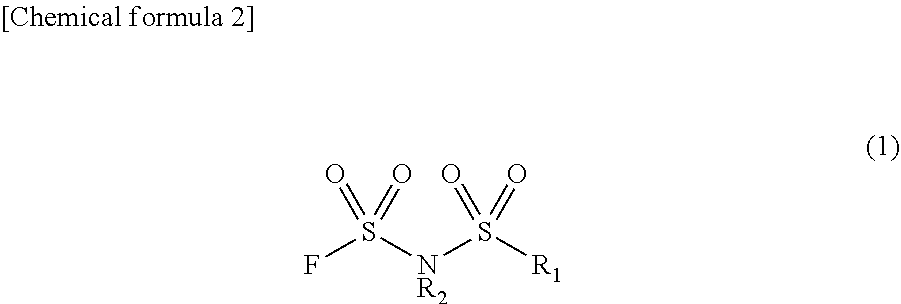Method for manufacturing electrolyte solution material
a technology of electrolyte solution and manufacturing method, which is applied in the field of fluorosulfonyl imide, can solve the problems of difficult removal of impurities, and achieve the effects of low cost, improved workability, and reduced cost of product production
- Summary
- Abstract
- Description
- Claims
- Application Information
AI Technical Summary
Benefits of technology
Problems solved by technology
Method used
Image
Examples
production example 1
m di(fluorosulfonyl)imide (LiFSI)
[0057]Into a 500-mL PFA-made reaction container equipped with a stirrer and a condenser, 120 g of butyl acetate was introduced. Subsequently, 16.1 g of di(chlorosulfonyl)imide (75 mmol) was further introduced into the reaction container. The resultant solution was stirred to dissolve the compounds. To the resultant di(chlorosulfonyl)imide solution, 4.45 g of ammonium chloride (82.5 mmol) was added, and the solution was stirred at 80° C. for 1 hour. Acidic ammonium fluoride NH4F.HF (20.53 g) (360 mmol) was added to the di(chlorosulfonyl)imide solution, and the resultant solution was further stirred at 80° C. for 4 hours.
[0058]After the completion of the reaction, the reaction solution was cooled to room temperature, and then a solid material was removed by filtration. The filtrate was transferred to a separating funnel, then an aqueous solution prepared by dissolving 3.15 g (75 mmol) of lithium hydroxide monohydrate in 21 g of ultrapure water was adde...
example 1
[0060]A lithium di(fluorosulfonyl)imide powder (4.99 g) containing butyl acetate (208 ppm) and dichloromethane (4621 ppm), which was prepared separately, and diethyl carbonate (7.56 g) were placed in a 50-ml eggplant flask, and the mixture was dissolved. The solution was decompressed at 25° C. and 1 kPa for 3 hours to volatilize the solvent. In this manner, 11.64 g diethyl carbonate solution of lithium di(fluorosulfonyl)imide was produced as an electrolyte solution material. The solution thus produced contained butyl acetate at a concentration of 83 ppm, but the presence of dichloromethane was not confirmed. Dichloromethane, which had low affinity for lithium di(fluorosulfonyl)imide, was reduced through the volatilization step.
example 2
[0061]In a 25-ml eggplant flask, ethylene carbonate (EC) (4.76 g) was added to a lithium di(fluorosulfonyl)imide powder (3.23 g) containing butyl acetate (208 ppm) and dichloromethane (4621 ppm), thereby the mixture was dissolved. The solution was decompressed at 25° C. and 1 kPa for 3 hours to volatilize the solvent. In this manner, 7.83 g of an ethylene carbonate solution of lithium di(fluorosulfonyl)imide was produced as an electrolyte solution material. It was confirmed that the solution thus produced contained 85 ppm of butyl acetate and 40 ppm of dichloromethane.
PUM
| Property | Measurement | Unit |
|---|---|---|
| volatilization temperature | aaaaa | aaaaa |
| temperature | aaaaa | aaaaa |
| temperature | aaaaa | aaaaa |
Abstract
Description
Claims
Application Information
 Login to View More
Login to View More - R&D
- Intellectual Property
- Life Sciences
- Materials
- Tech Scout
- Unparalleled Data Quality
- Higher Quality Content
- 60% Fewer Hallucinations
Browse by: Latest US Patents, China's latest patents, Technical Efficacy Thesaurus, Application Domain, Technology Topic, Popular Technical Reports.
© 2025 PatSnap. All rights reserved.Legal|Privacy policy|Modern Slavery Act Transparency Statement|Sitemap|About US| Contact US: help@patsnap.com



